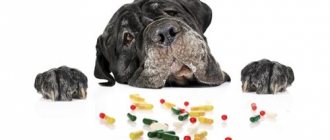Being the owner of a four-legged pet is not only the joy of walks, active games and fun pastime. Unfortunately, many dog owners are faced with various diseases and pathological conditions that lead to a deterioration in health and a threat to the dog’s life.
White or yellow foam from the mouth of dogs is a sign that is very frightening to humans. Almost all owners immediately assume the development of an infectious or bacterial disease. Sometimes even thoughts arise that the disease can affect other family members. Of course, every owner wishes his tailed friend all the best, so it is important to know what reasons can lead to the appearance of foam and what help is needed.
What does foamy discharge from the mouth look like?
The appearance of foamy liquid occurs during a chemical reaction of oxygen with saliva and gastric mucus. It is similar to soap formations, but may contain veins and inclusions. Color and consistency often help determine the root cause of the appearance.
The foam itself is not dangerous, but sometimes it acts as a symptom of diseases of the digestive system and other pathologies. The presence of violations is indicated by an increase in the amount of fluid coming out, more frequent attacks of vomiting, and the appearance of accompanying symptoms.
Where does the foamy substance come from?
Foaming at the dog's mouth is excess saliva or protective stomach mucus that has formed in the mouth. It occurs after contact of these liquids with an open medium (air). There are many reasons why foam appears from a dog’s mouth; they are physiological or pathological in nature. In the first case, nothing dangerous for the animal happens. This is a common chemical reaction that occurs quite often. A dog may drool if it is in a stressful situation, angry or scared.
Animal under drip
In the second case, we are talking about a disease, sometimes dangerous not only for the animal, but also for humans. White blisters at the edge of the mouth are one of the signs of rabies or distemper. Without knowing exactly what is the cause of the strange phenomenon, it is worth taking the dog to the veterinarian.
Reasons for violation
The causes of a possible violation are physiological and pathological. The former occur in healthy animals for natural and non-hazardous reasons. The latter are associated with serious disorders of an infectious and non-infectious nature that threaten the health of the animal.
Physiological
Most physiological reasons are associated with the peculiarities of the digestive process. These include:
- Prolonged fasting. A long absence of food leads to increased production of gastric juice, which irritates the mucous membranes. As a result, white foam flows from the dog’s mouth.
- Quick swallowing of food. Occurs in the absence of satiety or prolonged fasting.
- An accumulation of hairballs or grass. Hair and plants are difficult to digest and are often removed by the body through vomiting. In this case, the foamy mucus has a green or yellowish tint and contains particles of fur.
- Eating bitter or salty foods. They irritate the receptors, stimulating saliva production. This often happens when a dog is given a bitter medicine.
Also, excessive salivation occurs when chips get stuck between the teeth or a foreign object gets into the digestive tract. In both cases, saliva comes into contact with oxygen and begins to bubble. Danger arises when blood appears. This occurs when soft tissue is damaged, so the animal should be shown to a veterinarian.
“
Foamy saliva also appears when taking pills. Dogs do not like to swallow them the first time, so wandering around the mouth leads to temporary drooling.
If your dog is foaming at the mouth, make sure there are no stress factors. The reaction can also be caused by motion sickness during a long trip or toxicosis. Such cases are rare. Symptoms resolve on their own.
Large, loose folds located around the jaws of Bulldogs and Boxers prevent saliva from being retained in the mouth. The slight foamy discharge in these breeds is explained by their anatomical structure.
Pathological
If the appearance of foamy liquid is accompanied by other symptoms and a sharp deterioration in the condition, contact your veterinarian immediately. In this case, there is a high probability of a pathological cause:
- Viral infections (rabies, enteritis, distemper, Aujeszky's disease). Self-medication for these diseases is useless, and in the case of rabies, it is dangerous for humans. If your pet avoids light, and its behavior has suddenly changed to the opposite, isolate it and call a veterinarian.
- Neoplasms in the esophagus and oral cavity. A biopsy is used to confirm or refute oncology.
- Diseases of the cardiovascular system. In case of cardiac pathologies, blue mucous membranes and the appearance of a dry cough are noted.
- Food poisoning. Eating spoiled or poisoned substances causes intoxication. Along with vomiting, the body tries to get rid of the toxins it has received.
- Dental diseases. Due to the presence of pathogenic microorganisms that change the chemical composition, the dog's saliva looks like foam.
- Epilepsy. The disease is incurable, so the owner can only stop subsequent attacks. Those at risk include spaniels, poodles and labradors.
- Helminthiases. Foamy vomit occurs when infected with esophageal worms.
- Diseases of the pancreas and gall bladder. The appearance of yellow foam in a dog that has not eaten grass is due to bile that has entered the stomach. This problem is typical for small breeds.
- Stomach bleeding. Foamy liquid, colored brown, indicates injury to internal tissues.
- Brain damage. Concussions, inflammation, swelling and bruises are accompanied by vomiting, heavy breathing and loss of consciousness.
To eliminate these pathologies, a thorough diagnosis is necessary. Attempts at self-treatment can aggravate the patient’s condition or lead to his death.
After anesthesia and surgery
A separate reason is operations performed under general anesthesia. Anesthesia is toxic, so it will take some time to remove it from the body. After sterilization or other surgical intervention, the animal’s temperature decreases and the mucous membranes turn pale. On the first day, mild cramps, diarrhea and nausea are acceptable. If the condition does not stabilize, see a veterinarian and surgeon.
Is there prevention?
It is not always possible to prevent the appearance of an unpleasant symptom, but prevention will not be superfluous. The dog owner should:
- accustom her to moving in a carrier or in a muzzle (training begins at 2-3 months, not only walking with the puppy, but also transporting him in a train or taxi);
- monitor the quality and quantity of food;
- get vaccinated on time;
- do not forget about the need for deworming;
- Keep toxic drugs and household chemicals away from animals.
On the street, the dog is kept away from garbage cans, not allowed to pick up sticks or stones from the ground, or dig holes.
There's a plague in the land
Foaming at the mouth of a dog is not always the norm. But a conclusion about its pathological nature must be made by a veterinarian. Attention is paid to the breed and behavior of the animal. So, boxers' jaws are designed in a special way, which is why saliva constantly comes out of their mouths. If we are talking about a mongrel, then the owner needs to think about consulting a specialist and further treatment.
Associated symptoms
Record each of the accompanying symptoms in detail. They will help the veterinarian during diagnosis.
Shaking your head
If your pet shakes its head, check its mouth. He may be trying to get rid of stuck wood chips or other foreign objects.
Convulsions
If your dog is foaming at the mouth and has convulsions, the cause may lie in an epileptic seizure or poison intoxication. Convulsions in epilepsy are accompanied by involuntary urination and bowel movements, as well as complete disorientation in space. In case of poisoning, dilation of the pupils and a decrease in body temperature are noted.
Vomiting and gastrointestinal upset
If your dog comes out of his mouth not only with foam, but also with vomit, examine the color and consistency of the vomit. This will be needed when collecting anamnesis.
When an animal vomits, it is often tormented by painful spasms and diarrhea. Such symptoms are extremely dangerous for puppies, as they quickly dehydrate the body.
Heart rhythm disturbances
Count your heart rate or the number of breaths you take in minutes. Rapid breathing may cause cardiac arrest, so contact your veterinarian for further advice.
Do I need to see a veterinarian?
Vomiting blood in a dog: causes of nausea
You should take your dog to the veterinarian at least 2 times a year. In rural areas, specialists often go door to door and examine all animals, including dogs, and vaccinate them. City residents must monitor this process on their own.
There is no need to worry that complaints will not be taken seriously. It is possible that there is no reason to panic, but you need to be on the safe side, especially if you own a purebred dog.
Allergy
Help and treatment
Foaming from the mouth in a puppy or adult dog for no apparent reason is an alarming symptom that requires diagnosis. To eliminate it, you will need to deal with the root cause.
The owner's first actions
If you do not have the opportunity to immediately go to a veterinary clinic, provide first aid to your pet. To alleviate his condition you will need:
- Provide access to clean water. If the animal refuses to be fed, do not insist. For severe vomiting, use ice cubes instead of plain water.
- Give a deworming tablet. If found in stool or vomit, collect a sample for laboratory diagnosis.
- Lay the body on the right side in case of an epileptic attack. Hold your dog's head to prevent him from choking on foam and swallowing his tongue. Remove all dangerous objects from the pet's vicinity and wait until the seizure ends.
- Give activated carbon. In case of poisoning, the sorbent is given every 4 hours.
- Examine the oral cavity. If you find a splinter, “rain” or threads, carefully remove them out. Leave sharper objects for the vet.
In most cases, self-medication is ineffective, so try to take the animal to a veterinarian. Further treatment will be prescribed after diagnosis and identification of the cause.
Medicines prescribed by your veterinarian
Viral and bacterial infections are treated with antiviral drugs or antibiotics, respectively - they prevent the addition of secondary diseases. Immediately after infection, immune serum can be used. If a dog is diagnosed with rabies, it will have to be euthanized, since this disease cannot be treated.
Surgery is used to eliminate tumors. If cancer is detected, chemotherapy may be used.
Heart pathologies require gentle nutrition and the use of medications that support the functioning of the organ. Swelling is relieved with diuretics.
Toxins trapped during poisoning are removed by washing. An antidote is used to eliminate the harmful effects of poisons.
Dental pathologies are eliminated under anesthesia. The animal's teeth are cleaned, caries, stomatitis and other diseases are removed. If gum damage is severe, antibiotics are prescribed.
New attacks of epilepsy are suppressed by taking anticonvulsants, and helminths are fought with anthelmintics. The greatest effect is provided by broad-spectrum drugs that act on several groups of parasites at once. Large gallstones are removed surgically under general anesthesia.
In case of internal bleeding and brain damage, the animal is placed in a hospital. Once the dog's condition has returned to normal and the dog's mouth has stopped foaming, the veterinarian will decide what to do next, depending on the severity of the situation.
Is it possible to warn?
It is easier to prevent any disease than to treat it later. By neutralizing the factors that can cause a dog to foam at the mouth, this condition can be prevented.
- Train the vestibular apparatus of your pet, starting with short-distance transport and gradually increasing their length. Carry more often, starting from puppyhood. Immediately before traveling by car or bus, you can apply something against motion sickness.
- For small breed dogs (especially Yorkies), carefully monitor their diet, avoiding sudden changes in the assortment and do not immediately feed large amounts of a new product.
- Get vaccinations and deworming in a timely manner.
- Treatment against blood-sucking skin parasites should be carried out strictly according to the instructions and apply the products strictly to those places where it is not possible to lick them off.
- Keep household chemicals and various toxic substances out of reach of the dog.
- Strictly ensure that the animals do not grab anything from the ground (stones, frogs, sticks, etc.) - foreign objects can harm both the adult and the puppies.
Ways to alleviate the condition
To alleviate your pet's condition before visiting a doctor, some procedures are performed. If the dog is prone to allergies, an antiallergic drug is given. For example, Suprastin, Loratadine, Claritin are suitable. The second step is cooling the swollen area. Take a bottle of chilled water, wrap it in gauze, and apply it to the swelling.
An antibacterial ointment is used, for example, Tetracycline. The main thing is to monitor your pet so that he does not scratch his eyes, as his paws will spread an infection that will aggravate the eye condition.
If the animal’s health deteriorates sharply and the procedures do not help, you should immediately take the dog to the clinic.
An examination by a specialized doctor is better than self-medication. On the first visit to the veterinarian, the pet will be examined, the cause of the swelling will be determined, and preliminary tests may be prescribed. Once the results are received, appropriate treatment will be prescribed. If surgical intervention or mini-operation is required, it will be done immediately on the spot. You will need to administer antibiotics, serum for snake bites or poisonous insects - the necessary procedures will be carried out on the spot and instantly.
Is it dangerous
Although foam from the mouth of dogs in some cases does not cause a threat to life, when it appears, it is necessary to show your pets to a veterinarian. Perhaps discharge is the first sign of a serious disease that requires complex treatment. If there is no reason for concern, the doctor will give his recommendations to eliminate repeated cases of foam-like substance appearing from the mouth.
When foam is a symptom of illness
If light, bubbly discharge is an independent symptom and does not have a negative effect on the pet’s condition, it may have appeared as a physiological reaction to an external irritant. If negative symptoms appear frequently and are accompanied by other signs that negatively affect the dog’s condition, then it is advisable to contact a veterinarian. You can tell that your pet is in danger by symptoms such as:
Important! If the dog begins to lose weight sharply and changes in behavior, this may also indicate a serious illness.
Associated symptoms
Concomitant symptoms before the appearance of foamy discharge from the mouth may include:
- weakness;
- loss of appetite;
- hiccups;
- cough.
The dog may also experience an increase in temperature and seizures.
What dog breeds are at risk?
Veterinarians say that dogs of both small and large breeds are at risk: terrier, Labrador, beagle, sheltie, keechonde, poodle, St. Bernard.
Foam from the dog's mouth
Vomiting in dogs: pathology. Distinctive features
Dog vomiting white foam
The owners are faced with the problem that the dog is vomiting white foam. Should we panic?
This phenomenon has a physiological explanation. When food enters the stomach, it is exposed to the action of digestive enzymes - hydrochloric acid and pepsin. She stays there for a short time, about an hour or two. Next, the pyloric sphincter opens and food moves through the intestines, where it is further broken down. Meanwhile, mucus forms in the stomach, freed from food. It performs a protective function, protecting the walls of the stomach from the action of hydrochloric acid. It contains proteins and polysaccharides. By combining with the incoming air, structurally cellular masses are formed. Therefore, if your dog is vomiting white foam and mucus, there is no need to worry too much. If the condition occurs once, there is no need to resort to treatment. But, if this occurs more than once, and even more so occurs systematically, then
Do not put off visiting the veterinary center.
If this happens before eating, then there may be a violation of bile secretion . In a healthy body, it acts on food that passes from the stomach to the small intestine. Here it is released into the intestinal lumen and thrown into the stomach, causing vomiting. This is not evidence of an animal’s illness and can occur once a week.
Vomiting in a dog with gastritis
White foam can be observed if the animal has gastritis. This disease is characterized by the fact that a sufficient amount of acid accumulates in the stomach overnight. It has an irritating effect on the stomach walls and can cause a gag reflex. If this occurs with a certain frequency, then this is a sure sign of inflammatory processes in the gastrointestinal tract. This also happens due to heartburn. You must adhere to a diet, but it is best to consult a veterinarian. With flatulence, bloating is observed. The intestines may become swollen from excess gas. The stomach can swell either after eating or after some time due to intestinal volvulus. The abdomen may become bloated due to physical activity of the dog after a heavy meal.
Gases accumulated inside the intestines move towards the stomach and thereby cause a gag reflex. On top of everything else, the animal begins to have a severe stomach ache. Because of the pain, the animal is in an excited state, does not obey, and does not care about anything. With flatulence, the abdomen increases in size and intestinal rupture may occur. Fecal peritonitis develops . White foam may be a sign of rabies. This disease is also dangerous for humans. Of course, it is difficult to determine this disease on your own. But, if phenomena such as numbness or eating inedible objects appear, then immediately contact a veterinary center.
Dog vomiting blood
If your dog is foaming at the mouth red , then it is most likely blood. The presence of blood is a sign of damage to the mucous membrane of the stomach or esophagus
. It can be damaging due to mechanical action. For example, sharp bones, nails and other objects. Infections: enteritis, leptospirosis, hepatitis. Heavy metals and rat poison lead to poisoning. Some liver diseases cause a gag reflex. If you notice your dog vomiting blood, remember that self-medication is very dangerous. Ignorance of the real reasons that caused this condition can seriously harm the dog. Only a veterinarian can diagnose an animal. The sooner you contact a specialist, the sooner your pet will receive qualified assistance.
Taking medications incorrectly can only worsen the condition and cause stomach bleeding. Please note that vomit may contain impure blood. They can be not only red, but can be the color of coffee grounds, red-brown and even black. This occurs due to the combination of blood with gastric juice, so it can be difficult to correctly determine whether there is blood in them.
Vomiting in a dog - how to stop it?
How does a dog stop vomiting?
If the dog is vomiting blood , and it is impossible to go to the veterinary center, then it is necessary to quickly provide first aid and this must be done immediately. Your actions:
- Do not give food for 24 hours;
- The dog must be completely at rest;
- Give 2 tablets per day of the drug “Kvamatel”. One in the morning, one in the evening.
If the animal is lethargic and the temperature has risen
, then most likely this is the beginning of the development of a viral disease or liver pathology.
There is no point in delaying self-medication and it can only cause harm. At the first opportunity, you should immediately contact a veterinarian, where your pet will be prescribed symptomatic treatment . Once such a situation arises, there is no reason to postpone a visit to a specialist. The disease can become chronic, which means relapses will occur, so timely diagnosis will make your pet feel better and save him from unwanted consequences.
Dog vomiting yellow foam
A dog's vomiting, which is yellow in color, may indicate the presence of many diseases. For example, pancreatitis, cholecystitis, hepatitis. There are diseases that occur in a latent form, without obvious signs, such as piroplasmosis. Noticing yellow foam at the mouth of a dog
, we can conclude that there is an admixture of bile there.
If the animal only eats once a day, then try to help it yourself by changing its diet. Try to feed the animal 3 times a day in small portions. If this does not help, contact a specialist. The animal may have cholecystitis. With this disease, bile is released into the intestines, irritating its walls, which leads to vomiting. Vomiting bile in a dog may be due to worms. Contact your veterinarian. He will make a diagnosis after an examination, which includes a biochemical and general blood test, ultrasound. All this can be done at a veterinary center. An advanced disease and not provided timely assistance can lead to the death of the animal. If a puppy vomits at the age of 3 months, it is contraindicated to treat it independently
. In this case, you should immediately contact your veterinarian.
Answer
For the owner, swelling of the pet's eyes becomes an unpleasant moment. It is provoked by an eye infection and a disease of another organ of the dog’s body.
There are many problems associated with eye swelling, here are just a few:
- Conjunctivitis is an inflammation of the eye, accompanied by the discharge of pus and lacrimation. With this inflammation, the eyes begin to itch.
- Allergic reaction to external factors, food, household chemicals, wool shampoos. This type is dangerous because the eyes, nose, muzzle and even lungs swell. Pulmonary edema is fatal.
- Blepharitis is accompanied by watery eyes, itchy eyes, and it is difficult to perceive bright light. This is inflammation of the eyelid.
- Turning of the eyelids. The eyelashes injure the cornea, resulting in the release of pus, accompanied by lacrimation.
- Short-term swelling of the eye is caused by heart or kidney disease.
It is strictly forbidden to treat eye swelling on your own; a visit to the veterinarian is required.
What to do?
The owner's help will mainly depend on the reason that provoked this condition. Sometimes all the owner can do is get the pet to the clinic as quickly as possible.
- When “hungry” foam appears, it is enough to wait for the condition to normalize, give him a little water and give him something to eat.
- If “multi-colored” foam was noticed, this is a reason to visit the veterinarian, because... It will not be possible to help on your own due to the impossibility of making an accurate diagnosis without additional tests and examination by a specialist.
- If foam containing worms is detected, the dog needs to be wormed. It is enough to purchase a broad-spectrum anthelmintic and give it in a dosage, taking into account the pet’s age and necessarily weight. If possible, take it along with the released worms to a hospital so that the drug can be prescribed by a veterinarian.
- If you suspect an epileptic seizure, you need to carefully lay the dog on its right side (it will be easier for her to breathe this way), lightly hold her head and under no circumstances try to restrain convulsions. Remove any objects around that could cause injury to your pet due to uncontrolled body contractions. After the attack ends, you need to go to a hospital. Also, the dog should be taken to the doctor immediately if the attack does not stop for more than 10 minutes. The doctor will provide appropriate assistance and (after additional examination) a course of anticonvulsants (symptomatically or systematically) will be prescribed.
- Poisoning with strong poisons - the dog needs cleansing enemas, possibly an antidote, adsorbents, diuretics and recovery drips. If the owner does not know exactly what caused the poisoning, it is better not to hesitate and go to a specialist.
- If the foam is pink (red) and there is no deterioration in the general condition, you can allow yourself to independently examine the mouth for the presence of foreign objects, oral injuries or stomatitis. If there is no doubt that the foreign body can be eliminated on its own, you need to act. If in doubt, you need to seek help from a veterinarian.
- For stomatitis, it is advisable that the treatment be prescribed by a specialist - antibiotic therapy, antiseptic solutions, wound-healing ointments or gels.
- If a dog has all the signs of an infectious disease (rabies, plague, etc.), then there is no need to take independent measures (with rabies this can still be dangerous for humans). If rabies is suspected, the dog should be isolated and a veterinarian should be called to the home. Treatment of plague should be prescribed by a veterinarian, and in severe cases it should be carried out under his strict supervision. The main direction of treatment is antibiotic therapy to prevent the development of secondary bacterial infections, antiviral drugs, detoxicants, restoratives and immunostimulating agents.











